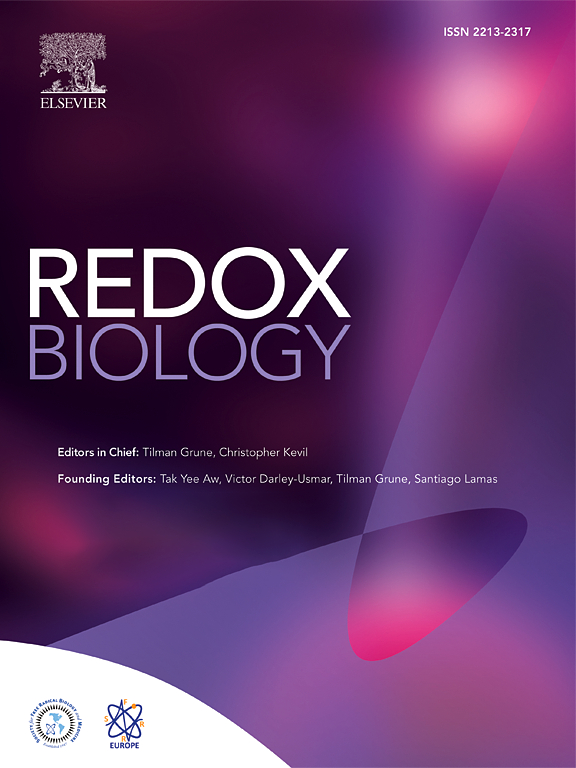运动诱导的去卵巢小鼠骨骼肌线粒体保护:肌源性E2合成独立机制
IF 11.9
1区 生物学
Q1 BIOCHEMISTRY & MOLECULAR BIOLOGY
引用次数: 0
摘要
骨骼肌是一种对17β-雌二醇(E2)敏感的组织,由于绝经后E2缺乏和随后的线粒体功能障碍,骨骼肌容易加速衰老。虽然外源性E2治疗已被证明可以保护去卵巢啮齿类动物免受线粒体损伤,但运动诱导的骨骼肌局部E2产生对线粒体功能的影响仍有待确定。本研究探讨了运动介导的去卵巢小鼠线粒体保护和肌源性E2的作用。本文章由计算机程序翻译,如有差异,请以英文原文为准。
Exercise-induced mitochondrial protection in skeletal muscle of ovariectomized mice: A myogenic E2 synthesis-independent mechanism
Background
Skeletal muscle, a 17β-estradiol (E2)-sensitive tissue, is prone to accelerated aging due to postmenopausal E2 deficiency and subsequent mitochondrial dysfunction. While exogenous E2 treatment has been shown to protect against mitochondrial damage in ovariectomized rodents, the impact of exercise-induced local E2 production in skeletal muscle on mitochondrial function remains to be determined. This study investigated exercise-mediated mitochondrial protection in ovariectomized mice and the contribution of myogenic E2.
Methods
Female C57BL/6J mice (8-week-old) were divided into Sham, OVX, and OVX + ET groups (N = 12). OVX mice underwent bilateral ovariectomy, with the OVX + ET group performing 8 weeks of treadmill exercise starting 10 weeks post-surgery. Functional tests (grip strength, fatigue resistance) and gastrocnemius analyses (morphology, mitochondrial function, E2/antioxidant levels, and protein expression) were conducted. Parallel experiments in muscle-specific aromatase knockout (MS-ARO-CKO) mice included E2 supplementation via subdermal pellets.
Results
18 weeks after ovariectomy (OVX), C57BL/6J mice exhibited significant reductions in grip strength (∼30 %), rotarod performance (∼57 %), and grid hanging performance (∼92 %). Concomitantly, OVX led to marked decreases in mitochondrial respiration (p < 0.05) and antioxidant capacity (p < 0.05) in the gastrocnemius muscle, accompanied by alterations in mitochondrial quality control and antioxidant signaling proteins (p < 0.05). Exercise intervention effectively attenuated these OVX-induced deficits, accompanied by a 66 % increase in E2 levels and upregulation of aromatase (ARO) activity and expression (p < 0.05). In MS-ARO-CKO mice model, exercise failed to improve the impaired antioxidant capacity induced by OVX. However, exercise, similar to estrogen supplementation, restored mitochondrial function and related protein expression abnormalities induced by OVX (p < 0.05).
Conclusions
Our findings demonstrate that the protective effects of exercise on skeletal muscle mitochondria involve multiple mechanisms, independent myogenic E2 Synthesis, providing novel insights for improving skeletal muscle health in postmenopausal women.
求助全文
通过发布文献求助,成功后即可免费获取论文全文。
去求助
来源期刊

Redox Biology
BIOCHEMISTRY & MOLECULAR BIOLOGY-
CiteScore
19.90
自引率
3.50%
发文量
318
审稿时长
25 days
期刊介绍:
Redox Biology is the official journal of the Society for Redox Biology and Medicine and the Society for Free Radical Research-Europe. It is also affiliated with the International Society for Free Radical Research (SFRRI). This journal serves as a platform for publishing pioneering research, innovative methods, and comprehensive review articles in the field of redox biology, encompassing both health and disease.
Redox Biology welcomes various forms of contributions, including research articles (short or full communications), methods, mini-reviews, and commentaries. Through its diverse range of published content, Redox Biology aims to foster advancements and insights in the understanding of redox biology and its implications.
 求助内容:
求助内容: 应助结果提醒方式:
应助结果提醒方式:


